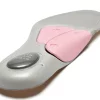I spend a good deal of time trying out combinations of both shoes AND insoles. A goodly percentage of people who do a lot of walking (hiking) find that, while a shoe fits perfectly, the insole creates problems of support and cushioning, which can create problems with sore feet and ankles, lower back pain, and greatly exacerbate the creation of blisters.
THE FOLLOWING ARE MY PERSONAL OBSERVATIONS FOR THE BENEFIT OF THOSE WHO ARE NEW(ISH) TO BUYING WALKING (HIKING) SHOES/BOOTS. This is only MY opinion based on decades of experience when I have had to go through the process of getting my feet fitted.
Because of my wide feet, I find that it is harder to find a comfortably fitting shoe or boot. It takes a great deal of patience and perseverance to "dial in" a correct fit. The focus should be on how well the length and width fit when the shoe is properly tied. For me, and many others, a shoe or boot that is one to one and a half longer than the measured foot length is needed to prevent the toes from cramming and banging into the front of the shoe on downhill grades. Even a tightly cinched lace will not keep toes from getting banged up if the length of the shoe just barely clears the toes when standing on level ground.
It is the width of the foot, not the length of the foot, that is affected by swelling during long walks (hikes) with a loaded pack. If one's normal, everyday shoe size has a width that even feels just barely snug on the foot, that is a width-size that will feel like a clamp when walking (hiking) a long distance under load. It will create more of a problem for blistering.
So get a fit for a hiking (walking) shoe/boot that allows for proper length and width, THEN start paying attention to how the bottoms of one's feet feel while trying the shoe on while walking around the house. (A store will generally allow for shoe returns IF they are not worn outside. The only exception that I have found here in America is shoes/boots purchased from REI. Even if you have worn them for a year whilst pursuing outdoor activities, if you find you don't like them, REI will accept their return.
With modern materials, combinations of materials, and current manufacturing techniques, a shoe/boot that fits well for the trail does not require a rigorous period of a "break-in" routine. A shoe/boot that is fitted well for the trail is good to go, so to speak, right out of the box.
If the bottoms of the feet feel uncomfortable in the properly fitting shoes/boots, that has, sadly, become normal. More and more shoe manufacturers are selling their shoes with cheaply made inserts (insoles) which is why the market and manufacture of third party insoles (inserts) have exploded over the last decade. There are stores which specialize in selling insoles/inserts. Many shoe stores that cater to runners, hikers, and backpackers will also stock a good number of different after-market insoles.
So.... take your new, good fitting shoes/boots to one of these stores so that your can now find an insole that will properly fit and comfort the bottoms of your feet. You can also go online and ponder and order from the many varieties of insole offerings, but doing so means that you will need to allow more time for trial and error while you try out those that are ordered (and need to be returned if they don't feel good).
As with shoes/boots, they should feel good in the store. Don't fall for the malarkey that it takes time to break them in, or to get used to them, or to allow your feet to adapt to them. If your feet are fairly normal, with minor issues of metatarsal, pronation or supination mechanics, if it doesn't feel good in the store, it won't get better with use or with time.
Feet are so unique and individual, that a recommendation of brands, other than a critique of their quality control and longevity, is mostly useless. What I find to be good for my feet, might not work for yours. What I will say is this: I need adequate metatarsal support, otherwise the balls of my feet get really sore and feel like I have a hard pebble pounding at the front of my soles near my the balls of my feet. I also require pronation support, otherwise the shoes/boots begin to bend inwards.
For me, the show/boot brands that I currently have enjoyed over the last five years of heavy-duty hiking and backpacking are Oboz (Sawtooth) and New Balance (Leadville). Take it with a grain of salt





















